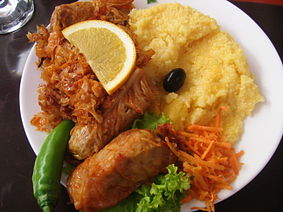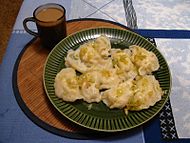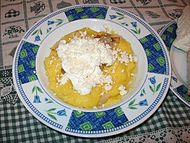
| Part of a series on the |
| Culture of Moldova |
|---|
 |
| History |
| People |
| Languages |
| Traditions |
| Mythology |
| Cuisine |
| Festivals |
| Religion |
| Art |
| Literature |
| Music |
| Media |
| Sport |
| Monuments |
| Symbols |
| Part of a series on the |
| Culture of Transnistria |
|---|
 |
| History |
| People |
| Languages |
| Cuisine |
| Festivals |
| Religion |
| Music |
| Media |
| Symbols |
Moldovan cuisine is a style of cooking related to the people of Moldova. It consists mainly of ingredients such as various meats, potatoes, cabbage, and a variety of cereal grains. The local cuisine is very similar to Romanian, and also draws inspiration and elements from other cuisines in the region, including Greek, Polish, Ukrainian, and Russian, with a great influence left by the Ottoman cuisine.
With the cuisine of Moldova being shared by another country, namely Romanian cuisine, there are similarities to these two cuisines of the two Romanian-speaking countries.
Background
Moldova's fertile soil (chernozem) produces plentiful grapes, fruits, vegetables, grains, meat, and milk products, all of which have found their uses in the national cuisine. The fertile black soil combined with the use of traditional agricultural methods permits the growth of a wide range of foods in Moldova.
Dishes
Perhaps the best-known Moldovan dish is also a well-known Romanian dish, mămăligă (a cornmeal mush or porridge). This is a staple polenta-like food on the Moldovan table, served as an accompaniment to stews and meat dishes or garnished with cottage cheese, sour cream, or pork rind. Regional specialties include brânză (a brined cheese) and friptură (a lamb or goat stew). Local wines accompany most meals.
Traditional Moldovan dishes combine diverse vegetables, such as tomatoes, bell peppers, aubergine, cabbage, beans, onions, garlic, and leeks. Vegetables are used in salads and sauces, and also baked, steamed, pickled (called murături), salted, or marinated.
The various kinds of borș (ciorbă) include a wide range of soups with a characteristic sour taste. These may be meat and vegetable soups, or fish soups, all of which are soured by borș (traditionally made from bran), or lemon juice. Chicken soup with meat, known as zeamă, is very popular.
Meat is traditionally served as an appetizer or first course. Roasted and grilled pork, beef meatballs (known as pârjoale and chiftele), and steamed lamb are common. Meat and fish are often marinated and then grilled.
Traditional holiday dishes include stuffed cabbage rolls with minced meat (known in Moldova/Romania as "sarmale", and in Turkey as "dolma"), pilaf (a rice dish), pork jelly, noodles, and chicken, among others. The holiday table is usually decorated with baked items, such as pastries, cakes, rolls, and buns, with a variety of fillings (such as cheese, fruit, vegetables, and walnuts), known (also in Romania) as cozonac, pască, brânzoaice (poale-n brâu), sfințișori, papanași, colaci, plăcinte, and cornulețe.
In certain areas, the cuisine of various ethnic minorities is predominant. In eastern Moldova, Ukrainians eat borscht; in the south, the Bessarabian Bulgarians serve the traditional mangea (chicken with sauce), while the Gagauz prepare shorpa, a highly seasoned mutton soup; in the Russian communities, pelmeni (meat-filled dumplings) are popular. Various dishes served at the New Year's Eve table include mostly Russian-influenced dishes such as shuba and salată de boeuf.
Other very popular dishes include a variant of pierogi called colțunași, filled with fresh white cheese (colțunași cu brînză), meat (colțunași cu carne), or cherries.
-
 Borș de burechiușe
Borș de burechiușe
-
 Mămăligă with cheese and greaves
Mămăligă with cheese and greaves
-
 Meatballs (chiftele)
Meatballs (chiftele)
-
 Tochitură
Tochitură
-
 Mămăligă
Mămăligă
Beverages
See also: Moldovan wineNon-alcoholic beverages include stewed-fruit compotes and fruit juice. Popular alcoholic beverages are divin (Moldovan brandy), beer, and local wine.
European grapes are used in the wine making. Popular grapes include Sauvignon, Cabernet, and Muscat. The main domestic Moldovan varieties include Fetească, Rara neagră, and Busuioacă albă.
Sparkling wine has a special place in Moldovan cuisine. The country produces large quantities of classic white and pink sparkling wines, as well as red sparkling wines that were originally introduced in Moldova. The most famous sparkling wines are those made in the Cricova winery. Well-known brands of Moldovan sparkling wines are Negru de Purcari, Moldova, Chişinău, Cricova, Muscat spumant, National, Nisporeni, etc. They are made from a wide range of European grape varieties, including Chardonnay, Pinot blanc, Pinot gris, Pinot menie, Sauvignon, Aligote, Traminer pink, Muscat blanc, Cabernet Sauvignon, and Pinot noir. The local variety Feteasca Albă, also used in sparkling wines, has been cultivated in Moldova since the times of ancient Dacia.
Postage stamps
See also
References
- Moldovan Cuisine Archived 2009-03-07 at the Wayback Machine on allmoldova.com
| Moldova articles | |||||
|---|---|---|---|---|---|
| History |  | ||||
| Geography |
| ||||
| Politics | |||||
| Economy | |||||
| Society |
| ||||
| European cuisine | |||||
|---|---|---|---|---|---|
| Sovereign states |
| ||||
| States with limited recognition | |||||
| Dependencies and other territories | |||||

